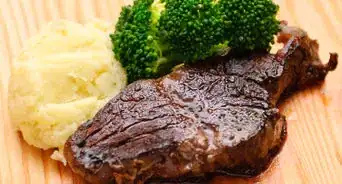This article was co-authored by Ririka Evans. Ririka Evans is a Personal Chef and the Founder of Home Cooking Solutions based in Frederick, Maryland. She has been a Chef for over 11 years at commercial kitchens across Japan and the US. She specializes in Japanese food and home-cooked meals. She creates customized menus and cooks for both families and special events. She’s prepared meals for clients from all walks of life, including public figures, CEOs, business owners, professionals, and busy families. She studied cooking and catering at Stratford Career Institute and is a certified ServSafe Food Protection Manager.
There are 14 references cited in this article, which can be found at the bottom of the page.
This article has been viewed 30,126 times.
Sesame oil is well-known as a cooking ingredient made from sesame seeds that adds a unique flavor to many Asian dishes. There are several types of sesame oil, so finding a use for them can be confusing at first. White sesame oil has a light yellow color to it and is often used for cooking. Dark, or toasted, sesame oil is brown and used to add a nutty flavor to finished dishes. Sesame oil is so versatile that it can even be used as a moisturizer or another part of your daily health regimen.
Steps
Cooking with White Sesame Oil
-
1Use sesame oil to cook meat and vegetables. Sesame oil can be used like any other type of cooking oil. It works best for sauteing any meat or vegetable. Pour the oil to the pan, heat it up, then add what you want to cook. Make sure you’re using the light-colored sesame oil, since the dark variety will cause your food to taste terrible if you cook with it for too long.[1]
- Regular sesame oil has a smoke point of about 410 °F (210 °C), so it can get pretty hot without burning.
- To substitute sesame oil you could use olive oil or avocado oil.
- You may sometimes see refined and unrefined white sesame oil. The refined variety is processed to resist higher temperatures, making it good for frying or cooking over high heat. The refined type is a little less heat resistant but more flavorful.
-
2Make stir fry dishes using sesame oil as a base. Combine about 1⁄2 teaspoon (2.5 mL) of sesame oil with up to 3 tablespoons (44 mL) of soy sauce and 1 tablespoon (15 mL) of rice vinegar. Mix it with additional ingredients like brown sugar, chili flakes, and sesame seeds if you prefer. Begin to cook the stir fry in olive oil and then pour the sesame sauce in with about 2 minutes to go. Stir the ingredients together as they cook to finish the stir fry.[2]
- A stir fry is the most common way to cook with sesame oil since it’s so customizable. Try adding up to 3 cups (450 g) of any veggies and 1 ½ cups (337.50 g) of meat you enjoy. Also, select up to 4 cups (400 g) of rice or noodles.
- Another way to make a stir fry is by cooking the ingredients directly in sesame oil. Many recipes combine the oil with soy sauce or another type of oil first, but it isn’t necessary. Both refined and unrefined sesame oil can be used this way.
Advertisement -
3Fry food by covering it with hot sesame oil. Sesame oil is relatively healthy and has a high heat resistance compared to other types of oil, making it a popular choice for frying. For example, heat 1⁄2 teaspoon (2.5 mL) of oil in a pan, then brown fresh dumplings in it. Sesame oil has also traditionally been used to fry food like tempura, cakes, and dough.[3]
- Tempura is basically a Japanese dish consisting of fried seafood or vegetables. To make it, coat the food in batter, then submerge it in a pot of hot sesame oil.
- Sesame oil isn’t used as frequently these days because it costs more than vegetable and canola oil. However, many people use it to make a lighter, crispier batter.
-
4Marinate meat in sesame oil to give it more flavor. Whip up a marinade to soak meat in before preparing it! You could combine 1 tablespoon (15 mL) of sesame oil with 2 tablespoons (30 mL) of low-sodium soy sauce and 1 tablespoon (15 mL) of lime juice for a basic marinade. Add seasonings like garlic, chili flakes, and ginger if you wish. Then, put the marinade in a bag with a piece of sirloin steak for at least 20 minutes.[4]
- Use unrefined sesame oil to give the meat a little bit of sesame flavor. If you prefer a stronger flavor, you can use dark sesame oil as long as you mix it with other liquids like soy sauce.
- A marinade can be made with whatever meat and seasonings you prefer. For instance, you could mix canola oil, rice wine vinegar, honey, and other ingredients. The marinade works well for flavoring chicken, beef, and even fish.
Flavoring Food with Dark Sesame Oil
-
1Whip dark sesame oil into a salad dressing. You could combine different ingredients to make your own salad dressing, such as a citrus vinaigrette. Try combining 1 teaspoon (4.9 mL) of dark sesame oil with 1 teaspoon (4.9 mL) of fresh orange juice and 1⁄4 teaspoon (1.2 mL) of cider vinegar. Mix in salt in pepper, then pour it onto vegetables like asparagus or lettuce. Add oranges, sesame seeds, and other ingredients for additional flavor.
- Toasted sesame oil works very well in all sorts of recipes, such as when it’s thickened with a flavorless oil like sunflower oil. Then, mix it with balsamic vinegar, soy sauce, honey mustard, and herbs to create an alternative vinaigrette.
-
2Turn the sesame oil into a sauce for meat and vegetables. Mix together whatever you like to create a flavorful sauce. A simple sauce can be made by combining 1⁄2 teaspoon (2.5 mL) of sesame oil with 1 tablespoon (15 mL) of soy sauce and 2 tablespoons (30 mL) of canola oil. Add 2 tablespoons (30 mL) of water as well. Then, mix in brown sugar or any other flavor ingredients you prefer.[5]
- The sesame oil has a strong flavor to it, so it is used in a small proportion to the other ingredients. That way, you taste the sesame oil without it becoming overwhelming.
- Dipping sauce is great for fries, raw vegetables, sushi, or even chicken tenders.
-
3Finish completed dishes with a drizzle of sesame oil. Toasted sesame oil goes well in a wide variety of dishes. Add about 1 tablespoon (15 mL) to soup, fries, or popcorn, for example. You could also toss cooked noodles or meat in the oil. It lends your food the nutty flavor of the sesame oil without having to cook with it.[6]
- Dark sesame oil is best when added within the last 2 minutes of cooking time or later. It can taste bitter or burned if you cook it too long.
- If you plan on using dark sesame oil for cooking, cook food at a low heat to prevent this from happening.
-
4Flavor hummus or other dips with dark sesame oil. Make hummus out of pureed edamame or another vegetable, for instance. Mix in about 1⁄4 cup (59 mL) of tahini, 1⁄4 cup (59 mL) of water, garlic, lime juice, and parsley. Then, blend it all together with 2 tablespoons (30 mL) of sesame oil.[7]
- Another way to incorporate sesame oil is with a spicy black bean dip. Blend a can of black beans along with 2 tablespoons (30 mL) of olive oil, and various flavorings like jalapeno, cumin, lemon juice, and tahini. Then,, finish it with about 1 tablespoon (15 mL) of sesame oil.[8]
Taking Sesame Oil for General Health
-
1Rub white sesame oil on clean skin to soften and heal it. After getting out of the shower, try applying the oil directly to your skin. Choose refined oil, since it is less likely to clog your pores. It doesn’t have to be diluted or washed off like essential oils. Try applying it to dry or scarred areas, especially if other products give you acne.[9]
- Sesame oil is said to soften acne scars. Exfoliate first to remove dry skin cells, then dab the oil on with a cotton ball.
- Sesame oil is also good for massages. Apply the oil to soften skin and make it more pliable.
-
2Work white sesame oil into your hair to moisturize it. Massage some oil into your scalp after washing your hair. Spread as much of it as you can on the dry ends if you have any. Like coconut oil and similar products, sesame oil is used to keep hair shiny and healthy. Wash it off after about 1 hour.[10]
- Many people believe sesame oil has other benefits, like shielding hair from harmful sun rays and age-related damage.
- Sesame oil can be combined with other things, such as almond oil or aloe vera, to make it more effective.
-
3Drink a little bit of white sesame oil each day for health benefits. Mix 1 tablespoon (15 mL) into a glass of water, then drink it. Do this up to twice a day. It’s a simple way to get the nutrients from sesame oil even when you don’t have time to cook with it. It is thought to help with mild constipation, among other problems.[11]
- Note that the health benefits that come from drinking sesame oil are not well-documented or proven. Before using the oil regularly, talk to your doctor about the potential side effects.
- Sesame oil has antioxidants and anti-inflammatory properties. For that reason, it may improve heart health, help control diabetes, and have other benefits.[12]
-
4Use white sesame oil as a mouthwash that eliminates bacteria. Sesame oil has long been used in Ayurvedic medicine for a process called oil pulling. Take 1 tablespoon (15 mL) of the oil, then swirl it around your mouth for up to 20 minutes. Once you’re done, spit the oil into a trash can. Finish by rinsing your mouth thoroughly with clean water.[13]
- Oil pulling is meant to draw out harmful bacteria and other toxins. However, its effects haven’t been well-studied, so don’t use it in place of regular brushing and flossing.
- Remember to spit the oil into the trash instead of down a drain. It can clog pipes.
Warnings
- Many of the health benefit claims around sesame oil have not been well-studied, and oil, in general, isn’t healthy if used in excess. To protect your health, speak with your doctor before regularly using sesame oil.⧼thumbs_response⧽
References
- ↑ https://whatscookingamerica.net/Information/CookingOilTypes.htm
- ↑ https://www.gimmesomeoven.com/quick-and-easy-stir-fry/
- ↑ https://www.loamagronomics.com/2019/02/21/pan-fried-veggie-dumplings-with-umami-sweet-spicy-chili-oil/
- ↑ https://www.food.com/recipe/ginger-sesame-marinated-steak-109308
- ↑ https://www.foodandwine.com/recipes/soy-sesame-sauce-tofu
- ↑ https://www.cookinglight.com/cooking-101/ways-to-use-toasted-sesame-oil
- ↑ https://www.halfyourplate.ca/4-dips-for-your-veggies/
- ↑ https://www.myrecipes.com/recipe/spicy-black-bean-hummus
- ↑ https://www.ncbi.nlm.nih.gov/pmc/articles/PMC4493737/


























































